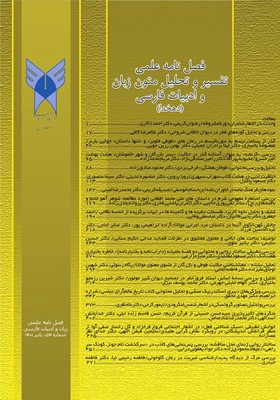شگردهای تأثیرپذیری سیدحسن حسینی از قرآن کریم
محورهای موضوعی : تطبیقی (با ویژگی ادبی و هنری)حسن قاسم زاده ابلی 1 , خدابخش اسدالهی 2 * , محمدرضا شاد منامن 3
1 - دانشجوی دکتری گروه زبان و ادبیات فارسی، واحد خلخال، دانشگاه آزاد اسلامی، خلخال، ایران.
2 - استاد گروه زبان و ادبیات فارسی دانشگاه محقق اردبیلی، اردبیل، ایران.
3 - استادیار گروه زبان و ادبیات فارسی، واحد خلخال، دانشگاه آزاد اسلامی، خلخال، ایران.
کلید واژه: اثرپذیری تلمیح, درج, قرآن کریم, سیّدحسن حسینی, ترجمه,
چکیده مقاله :
مطالعۀ آثار ادبی از منظر تأثیر و تأثر، رهیافتی در جهت کشف و شناخت بینامتنی است؛ شناختی که برجستگی طرز، و سیاق پیروی هنرمند را آشکار می سازد. بهره گیری متنوّع سیدحسن حسینی، از قرآن کریم، بیانگر آشنایی او با شگردهای مختلف تأثیرپذیری است. حسینی در استفاده از قرآن کریم، علاوه بر تأثیرپذیری به شگردهای مختلف، دارای نوآوری و انسجام فکری بوده و واژه سازی و آوردن ترکیبات تازه، از ویژگی های بارز اشعار قرآنی به شمار می آید. حسینی با نوآوری در زبان، آن را غنا بخشیده، و با به کارگیری واژه ای آشنا در بعدی تازه از ساختار جمله، معنای جدیدی به آن داده است. واژه ها و عبارات در شعر حسینی، ابزاری برای بیان اندیشه به شمار می آید و هدف او، القای مفاهیم متعالی است؛ به تبع آن، بهره گیری از قرآن کریم، علاوه بر جنبۀ هنری و بلاغی آن، در جهت اثبات عقیده، بیان احوال درونی، تقدس بخشیدن به سرودۀ خویش است. حسینی از اثرپذیری تلمیحی بیشترین بهره را گرفته است. این پژوهش با بهره گیری از منابع کتابخانه ای و به روش توصیفی-تحلیلی انجام گرفته است.
The study of literary works in terms of influence is an approach to intertextual discovery and cognition; Cognition that reveals the prominence of the artist's style, and context. Seyyed Hassan Hosseini's various uses of the Holy Quran indicate his familiarity with various techniques of influence. Hosseini in the use of the Holy Quran, in addition to being influenced by various techniques, has innovation and intellectual cohesion, and word formation and bringing new combinations are among the prominent features of Quranic poems. Hosseini has enriched it with innovation in language, and has given it a new meaning by using familiar words in a new dimension of sentence structure. Words and phrases in Hosseini's poetry are considered as a tool for expressing thought and his goal is to induce transcendent concepts; Consequently, the use of the Holy Qur'an, in addition to its artistic and rhetorical aspect, in order to prove the belief, to express the inner state, is to sanctify one's poem. Hosseini has benefited the most from the implicit impact.
کتابها
قرآن کریم.
آقا تهرانی، میرزا جواد، حسینی مجاهد، سیدمهدی (1388) تفسیر مصباح الهدی، با مقدّمۀ علّامه حکیمی، قم: موسّسۀ معارف اسلامی امام رضا(ع).
حسینی، سیدحسن (1396) مجموعه کامل شعرها، تهران: نشر آبی.
حلبی، سید علیاصغر (1371) تأثیر قرآن و حدیث در ادبیات فارسی، تهران: انتشارات اساطیر.
ثروتیان، بهروز (1377) بیان در شعر فارسی، تهران: برگ.
راستگو، محمّد (1387) تجلّی قرآن و حدیث در شعر فارسی، تهران: سمت.
شمیسا، سیروس (1374) سبکشناسی، تهران: فردوس.
غلامرضایی، محمّد (1377) سبکشناسی شعر پارسی از رودکی تا شاملو، تهران: جامی.
نادمی، احمد (1387) شمشیر باستانی شرق با خاطرۀ شاعر حماسهها و دریغها سیدحسن حسینی، تهران: هنر رسانهای.
مقالات
بیات، موسی، عدالتینسب، علی، تنگستانی، معصومه. (1393). بینامتنی قرآنی در شعر سید حسن حسینی. همایش ملی بینامتنیت (التناص)، 1(2)، 45-61.
حاجیزاده، مهین، تواضعی، رضا. (1396). بررسی تطبیقی سرچشمههای اجتماعی شعر امل دنقل و سید حسن حسینی با تکیه بر نظریه ساختارگرای تکوینی گلدمن. مطالعات تطبیقی فارسی و عربی، 2(3)، 118-85.
حجت، محمّد. (1387). اثرپذیرى دیوان صائب تبریزى از قرآن کریم. فصلنامه مطالعات ادبیات تطبیقی، 2(6)، 89-104.
صادقی، معصومه. (1397). سبکشناسی لایۀ واژگانی سرودههای پایداری سیدحسن حسینی. فصلنامه علمی مطالعات دفاع مقدس، 4(2)، 87-112.
عربی، فرشاد. (1389). «تجلّی قرآن و حدیث » در گلشن راز شیخ محمود شبستری بررسی شواهدی از اقتباس، تضمین و تلمیح. فصلنامه علمی عرفانیات در ادب فارسی، 2(5)، 106-93.
_||_Books
The Holy Quran.
Agha Tehrani, Mirza Javad, Hosseini Mujahid, Seyyed Mehdi (2008) Tafsir Misbah al-Hadi, with an introduction by Allama Hakimi, Qom: Imam Reza Institute of Islamic Education.
Gholamrezaei, Mohammad (1998) Persian poetry stylistics from Rudaki to Shamlu, Tehran: Jami.
Halabi, Seyyed Ali-Asghar (1992) The Influence of Quran and Hadith in Persian Literature, Tehran: Asatir Publications.
Hosseini, Seyyed Hasan (2016) The Complete Collection of Poems, Tehran: Abi Publishing.
Nadmi, Ahmed (2007) The ancient sword of the East with the memory of the poet of epics and hesitations Seyyed Hasan Hosseini, Tehran: Media Art.
Rastgo, Mohammad (2008) Manifestation of Qur'an and Hadith in Persian Poetry, Tehran: Samt. Sarvatian, Behrouz (1998) Expression in Persian Poetry, Tehran: Barg.
Shamisa, Siros (1995) stylistics, Tehran: Ferdous.
Articles
Arabic, Farshad. (2010). "The Manifestation of the Qur'an and Hadith" in Golshan Raz Sheikh Mahmoud Shabastri, examining the evidence of adaptation, guarantee and allusion. Scientific Quarterly of Mysticism in Persian Literature, 2(5), 93-106.
Bayat, Musa, Adalati Nasab, Ali, Tangestani, Masoumeh. (2013). Quranic intertextuality in Seyyed Hasan Hosseini's poetry. National Conference on Intertextuality (Altanas), 1(2), 45-61.
Hajizadeh, Mahin, Toveri, Reza. (2016). A comparative study of the social origins of the poetry of Amal Dangul and Seyyed Hasan Hosseini based on Goldman's developmental structuralist theory. Comparative Persian and Arabic Studies, 2(3), 85-118.
Hojjat, Mohammad. (2008). The effectiveness of Diwan Saeb Tabrizi from the Holy Quran. Comparative Literature Studies Quarterly, 2(6), 89-104.
Sadeghi, Masoumeh. (2017). The stylistics of the lexical layer of Seyyed Hasan Hosseini's poems of sustainability. Scientific Quarterly of Holy Defense Studies, 4(2), 87-112.

